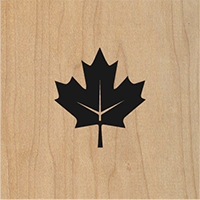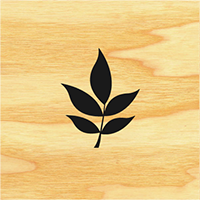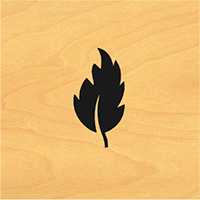The bowl-like indentation at the top of a wood bat. It allows us to remove weight if needed. Phoenix bats are cupped at 1.5” in diameter, leaving a thicker wall around the cup for enhanced structural integrity. Some competitors cup at 2”, leaving a very thin wall around the cup, increasing the chance of breaking.
Most customers select cupping, primarily because it has become the norm.
The number (often called “drop weight”) is the difference between bat length and bat weight. Take this number and add it (if the number is positive) or subtract it (if the number is negative) to the length you selected to determine the bat’s weight in ounces.
Ex. a 34” bat with a -2 Weight means the bat weighs 32 ounces (34 -2 = 32)
Ex. a 34” bat with a +1 Weight means the bat weighs 35 ounces (34 +1 = 35)
Bats with a 0 Weight will be equally as heavy as long.
Not sure what weight is best for you? We strongly suggest keeping the default recommended drop weight. This is the weight we targeted when we designed the bat and is most appropriate for a player swinging this model. It is pre-selected on the product page.
Why would a player choose a heavier bat? Because the player prefers it due to his size or due to use as a training bat. Some of our pros will start out batting practice with a bat that is an ounce heavier than what they swing in a game. Additionally, the heavier the bat, the greater the durability. But for the large majority of players, the trade-off of additional durability is not worth the loss in bat speed.
The bowl-like indentation at the top of a wood bat. It allows us to remove weight if needed. Phoenix bats are cupped at 1.5” in diameter, leaving a thicker wall around the cup for enhanced structural integrity. Some competitors cup at 2”, leaving a very thin wall around the cup, increasing the chance of breaking.
Most customers select cupping, primarily because it has become the norm.
TLengths are for wood bats, from knob end to barrel end. Select weight from the first column and height from the first row. Where they intersect on the chart is the recommended length of wood bat. See more info below the chart.
| < 3’0″ | 3′ – 3’4″ | 3’5″ – 3’8″ | 3’9″ – 4’0″ | 4’1″ – 4’4″ | 4’5″ – 4’8″ | 4’9″ – 5’0″ | 5’1″ – 5’4″ | 5’5″ – 5’8″ | 5’9″ – 6’0″ | 6’1″ – 6’4″ | 6’5″+ | |
|---|---|---|---|---|---|---|---|---|---|---|---|---|
| < 60 lbs | 25 | 26 | 27 | 28 | 29 | 29 | X | X | X | X | X | X |
| 61 – 70 lbs | 26 | 27 | 27 | 28 | 29 | 30 | 30 | X | X | X | X | X |
| 71 – 80 lbs | 26 | 27 | 28 | 28 | 29 | 30 | 30 | 31 | X | X | X | X |
| 81 – 90 lbs | 27 | 28 | 28 | 29 | 29 | 30 | 30 | 31 | 31 | X | X | X |
| 91 – 100 lbs | X | 28 | 28 | 29 | 29 | 30 | 31 | 31 | 32 | 32 | X | X |
| 101 – 110 lbs | X | 28 | 29 | 29 | 30 | 30 | 31 | 31 | 32 | 32 | 33 | X |
| 111 – 120 lbs | X | 28 | 29 | 29 | 30 | 30 | 31 | 31 | 32 | 32 | 33 | 33 |
| 121 – 130 lbs | X | 29 | 29 | 29 | 30 | 30 | 31 | 31 | 32 | 32.5 | 33 | 33 |
| 131 – 140 lbs | X | 29 | 29 | 30 | 30 | 31 | 31 | 32 | 32 | 32.5 | 33 | 33 |
| 141 – 150 lbs | X | 29 | 29 | 30 | 30 | 31 | 31 | 32 | 32 | 33 | 33 | 33 |
| 151 – 160 lbs | X | X | 29 | 30 | 31 | 31 | 32 | 32 | 32 | 33 | 33 | 33.5 |
| 161 – 170 lbs | X | X | X | 30 | 31 | 31 | 32 | 32 | 32.5 | 33 | 33.5 | 33.5 |
| 171 – 180 lbs | X | X | X | X | 31 | 31 | 32 | 32 | 32.5 | 33 | 33.5 | 34 |
| 181 – 190 lbs | X | X | X | X | X | 32 | 32 | 32.5 | 32.5 | 33 | 33.5 | 34 |
| 191 – 200 lbs | X | X | X | X | X | X | 32 | 32.5 | 33 | 33.5 | 33.5 | 34 |
| 200+ lbs | X | X | X | X | X | X | X | 32.5 | 33 | 33.5 | 33.5+ | 34+ |
PLEASE NOTE: This sheet should be used as a general reference/recommendation. We realize each player is different and is of a different skill level. Please keep in mind what size metal bat your player is currently swigging when looking into purchasing a Phoenix Bat. We suggest buying the same length wood bat to keep his/her swing consistent and to optimize training efforts.
*Weight in POUNDS *Height in Feet/Inches. *Bat length in Inches
IT’S NOT ABOUT HOW YOU HIT, IT’S ABOUT HOW YOU MISS-HIT!

Maple, the hardest wood for baseball bats, is the best choice for two different types of players:
– a player who mainly gets jammed when miss-hitting, taking the ball on the lower part of the barrel
– the player who has mastered hitting with a wood bat
A maple bat delivers the furthest ball distance, adding 10-15 feet as maximum energy gets transferred to the ball.

An ash wood bat is the best choice for a player who miss-hits primarily off the end of a baseball bat….as long as the player has the discipline to have the logo facing the sky when making contact with the ball. Ash is not as rigid or strong a wood as maple, allowing it to flex when hit on the side 90 degrees opposite the logo and engraving. That flex acts as a shock absorber for the cue-ball shots that may do in a maple bat. While absorbing some of the energy used to propel the ball, it’s better to lose a little power than an entire bat! Who should not swing ash: the hitter who tends to get jammed, miss- hitting towards the middle of the bat, just above the bat’s logo or the hitter who doesn’t pay attention to how they are holding the bat when striking the ball.

All-over the place when your miss-hit or new to swinging wood? Consider birch. It’s a bit stronger than an ash bat for the inside miss-hits and has some flex that a maple bat lacks for the outside miss-hits. From a wood strength and hitting distance standpoint, it falls in between maple and ash.
The more you hit with birch the harder it becomes. In about 50 hits, it will move closer to the pop of a maple bat, but never equal it.
Certain woods are not offered on certain lines of bats, primarily because we know they won’t hold up well. Secondarily, certain woods don’t yield proper bat weight, which is critical to developing/maintaining the right swing.
